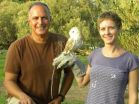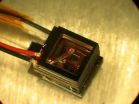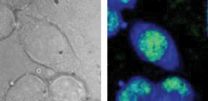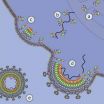(Press-News.org) COLUMBUS, Ohio – People who believe false rumors about the proposed Islamic cultural center and mosque near Ground Zero in New York City not only are more likely to oppose that project – they are more likely to oppose building of a mosque in their own neighborhood.
Researchers surveyed 750 Americans and asked them if they believed any of four rumors associated with the New York City mosque, all of which have been refuted. One of the rumors, for example, falsely says that that the proposed center is scheduled to open on September 11, 2011 in celebration of the 10-year anniversary of the World Trade Center attacks.
The findings suggest that among those who believed none of the four rumors, two-thirds are opposed to the proposed project. But that increases to 82 percent among those who believed three or more rumors.
Even more dramatic is the effect that belief in these rumors has on support for mosques outside of New York, said Erik Nisbet, co-author of the study and assistant professor of communication at Ohio State University.
Results suggest that predicted opposition to building of a mosque in the respondent's own neighborhood increased from 39 percent among people who believed none of the rumors to 63 percent among those who believed three or more of the rumors.
"These rumors have a negative effect well beyond the specific controversy in New York City," Nisbet said.
"They seem to shape attitudes about Muslims and their role in our society, no matter where we live. That's a big concern."
Nisbet conducted the study with R. Kelly Garrett, assistant professor of communication at Ohio State.
Another important finding of the study was that people who relied heavily on Fox News for their information were more likely than casual users to both know about the rumors – and to believe them.
The two researchers decided to survey Americans about the mosque controversy because it fit with both of their research agendas: Nisbet is interested in public opinion and American-Islamic relations, and Garrett is interested in the role of rumors in political communication.
They used the firm Survey Sampling International to recruit participants from a national online panel. Volunteer participants were surveyed between September 14 and 19, 2010.
While the 750 people surveyed represented a broad range of adults, it is not a representative sample of all Americans, and so the proportion of people in this study who have heard or believe rumors should not be taken as national averages, according to the researchers.
Instead, the study was designed to focus on how differences in exposure and belief in rumors and support for the proposed New York mosque were associated with media use.
In addition to the rumor concerning the opening date of the proposed center, participants were asked about three other false rumors. One was that Feisal Abdul Rauf, the Imam backing the proposed Islamic cultural center and mosque, is a terrorist sympathizer who refuses to condemn Islamic attack on civilians. Another is that the Muslim groups building the center have deep ties to radical anti-American and anti-Semitic organizations. The final rumor is that the money for the center is coming primarily from foreign financial backers associated with terrorist organizations.
These rumors were chosen because they were all listed as false by FactCheck.org, run by the Annenberg Public Policy Center, or PolitiFact, the Pulitzer-prize winning service of the St. Petersburg Times.
Survey participants were all asked to rate how much they relied on various media outlets for their news. They were also asked whether they heard any of the rumors and if they believed in them.
The results showed how reliance on specific media sources played a strong role in whether people were exposed to the rumors and if they believed them, Nisbet said.
People who said they relied heavily on Fox News, either online or on television, were more aware of the false rumors about the mosque and were more likely to believe these rumors compared to those with low reliance on Fox.
Findings suggest that a typical respondent who reported a low reliance on Fox News believed 0.9 rumors on average, while a similar respondent with a high reliance on Fox believed 1.5 rumors – an increase of 66 percent.
Garrett emphasized that all these comparisons in the study were made while holding constant other variables, including education, party affiliation, ideology, and other media use.
"Our analyses demonstrate that the relationships we found aren't just a side effect of some other characteristic, such as political ideology or party affiliation," Garrett said.
"These results suggest that even a well-educated, liberal Democrat would be more likely to believe the rumors, if he relied heavily on Fox for his news."
Reliance on conservative talk radio had a similar effect on users as did Fox News. Those with a heavy reliance on conservative talk radio heard on average two rumors, compared to 1.5 rumors for those with a low reliance – an increase of 33 percent.
Respondents who relied heavily on CNN or NPR believed fewer false rumors, the study found. High reliance on CNN reduced the number of rumors believed by 23 percent, while heavy use of NPR reduced belief by 25 percent.
People who relied heavily on broadcast television news – ABC, CBS or NBC – were less likely to have been exposed to the rumors. Heavy reliance on those sources was linked to a 22 percent decrease in rumor exposure compared to those with low reliance on those outlets. That may be because broadcast news had fewer reports on the mosque controversy than did the cable news outlets.
The best way to get accurate information about the proposed Islamic cultural center seemed to be newspapers, according to the study.
People who said they relied heavily on newspapers for their news (either print or online) increased their exposure to rebuttals by 67 percent when compared to people who relied little on papers. These rebuttals were shown to strongly promote accurate knowledge about the rumors.
Nisbet noted that this wasn't just because newspaper readers are more attuned to politics. Comparing people who paid similar attention to the mosque controversy, those who read newspapers still had greater exposure to the rebuttals.
"This is one of the unique contributions of newspapers in the media landscape," Nisbet said.
"When you consider that newspaper readers are more likely to be exposed to rebuttals of false information compared to other media outlets, it is worrying that newspapers in general have been struggling. It is something we should be concerned about."
### END
Study: Belief in rumors about proposed NYC mosque linked to opposition to all mosques
2010-10-15
ELSE PRESS RELEASES FROM THIS DATE:
Large gaps found in public understanding of climate change
2010-10-15
New Haven, Conn.—Sixty-three percent of Americans believe that global warming is happening, but many do not understand why, according to a national study conducted by researchers at Yale University.
The report titled "Americans' Knowledge of Climate Change" found that only 57 percent know what the greenhouse effect is, only 45 percent of Americans understand that carbon dioxide traps heat from the Earth's surface, and just 50 percent understand that global warming is caused mostly by human activities. Large majorities incorrectly think that the hole in the ozone layer ...
JILA unveils improved 'molecular fingerprinting' for trace gas detection
2010-10-15
Scientists at JILA and collaborators have demonstrated an improved laser-based "molecular fingerprinting" technique that picks out traces of key hydrogen-containing and other molecules from a billion other particles in a gas in just 30 seconds or less—performance suitable for breathalyzers for diagnosing disease, measuring trace gases in the atmosphere, detecting security threats and other applications.
JILA is jointly operated by the National Institute of Standards and Technology (NIST) and University of Colorado at Boulder (CU).
Described in Optics Express,* the research ...
CR Magazine sheds light on the burden of cancer on the streets
2010-10-15
PHILADELPHIA — An article published in the Ffall 2010 issue of CR, the AACR's magazine for cancer survivors and their families and caregivers, details the immense challenges faced by those who suffer with cancer and lack the necessary resources for proper treatment and care — the homeless.
CR magazine contributing writer Cynthia Ryan, Ph.D., who is an associate professor of English at the University of Alabama at Birmingham, took to the streets over the last year to offer a glimpse into the lives of homeless cancer patients struggling to obtain treatment while being ...
Cyberwars: Already underway with no Geneva Conventions to guide them
2010-10-15
BUFFALO, N.Y. -- Cyber attacks of various sorts have been around for decades. The most recent, and very dangerous, escalation in the past few years has been marked by countries launching attacks against other nations, such as Stuxnet, the nuclear plant-disrupting worm the Iranians have blamed on Israel and the U.S., while others are pointing the finger at Russia.
University at Buffalo military ethicist Randall R. Dipert, PhD, one of the founders of the National Center for Ontological Research at UB, says we have good reason to worry, because cyber attacks are almost ...
Is anxiety contagious?
2010-10-15
Anxiety, or the reaction to a perceived danger, is a response that differs from one animal or human to another ― or so scientists thought. Now researchers at Tel Aviv University are challenging what we know about stress, and their study has implications for helping clinicians better treat victims of terrorism or natural disasters.
Prof. David Eilam and his graduate student Rony Izhar of Tel Aviv University's Department of Zoology are spearheading a study designed to investigate the anxieties experienced by an entire social group. Using the natural predator-and-prey ...
NIST mini-sensor traces faint magnetic signature of human heartbeat
2010-10-15
Researchers from the National Institute of Standards and Technology (NIST) and the German national metrology institute have used NIST's miniature atom-based magnetic sensor to successfully track a human heartbeat, confirming the device's potential for biomedical applications.
Described in Applied Physics Letters,* the study is the first to be performed under conditions resembling a clinical setting with the NIST mini-sensors, which until now have been operated mostly in physics laboratories. The new experiments were carried out at the Physikalisch Technische Bundesanstalt ...
Biologists identify influence of environment on sexual vs. asexual reproduction
2010-10-15
TORONTO, ON – Evolutionary biologists at the University of Toronto (U of T) have found that environment plays a key role in determining whether a species opts for sexual over asexual reproduction.
The study, led by post-doctoral student Lutz Becks and Professor Aneil Agrawal of the Department of Ecology & Evolutionary Biology, found that species that inhabit spatially heterogenous environments – habitats characterized by uneven concentrations of its own species among a rich variety of other animals and plants – had higher rates of sexual reproduction than those in more ...
Faster CARS, less damage: NIST chemical microscopy shows potential for cell diagnostics
2010-10-15
A paper by researchers at the National Institute of Standards and Technology (NIST) may breathe new life into the use of a powerful—but tricky—diagnostic technique for cell biology. The paper,* appearing this week in the Biophysical Journal, demonstrates that with improved hardware and better signal processing, a powerful form of molecular vibration spectroscopy can quickly deliver detailed molecular maps of the contents of cells without damaging them. Earlier studies have suggested that to be useful, the technique would need power levels too high for cells.
The technique, ...
New look at multitalented protein sheds light on mysteries of HIV
2010-10-15
New insights into the human immunodeficiency virus (HIV) infection process, which leads to acquired immunodeficiency syndrome (AIDS), may now be possible through a research method recently developed in part at the National Institute of Standards and Technology (NIST), where scientists have glimpsed an important protein molecule's behavior with unprecedented clarity.
The HIV protein, known as Gag, plays several critical roles in the assembly of the human immunodeficiency virus in a host cell, but persistent difficulties with imaging Gag in a lab setting have stymied researchers' ...
New small business law could have big effect on retirement accounts
2010-10-15
CHAMPAIGN, Ill. – A new law aimed at helping stimulate small business job growth through tax deductions could have major consequences for anyone with a retirement savings account at work, a University of Illinois expert on taxation and elder law notes.
Law professor Richard L. Kaplan says an obscure provision in the recently enacted Small Business Jobs Act allows 401(k), 403(b) or 457 account holders to convert their retirement savings into a tax-advantaged Roth-version of the same account.
The good news, according to Kaplan, is that by converting to a Roth variant, ...





